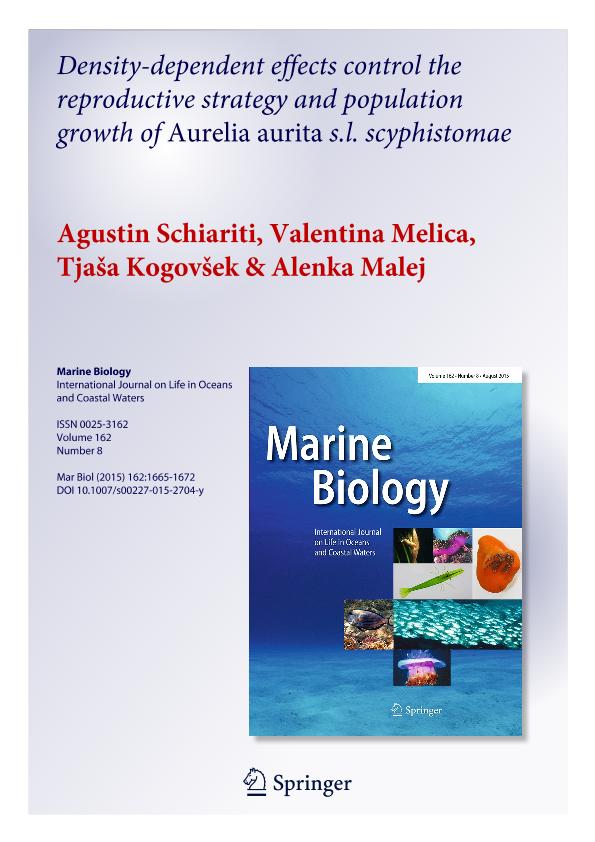Mostrar el registro sencillo del ítem
dc.contributor.author
Schiariti, Agustin

dc.contributor.author
Melica, Valentina
dc.contributor.author
Kogovsek, Tjasa
dc.contributor.author
Malej, Alenka
dc.date.available
2018-06-29T17:51:43Z
dc.date.issued
2015-08
dc.identifier.citation
Schiariti, Agustin; Melica, Valentina; Kogovsek, Tjasa; Malej, Alenka; Density-dependent effects control the reproductive strategy and population growth of Aurelia aurita s.l. scyphistomae; Springer; Marine Biology; 162; 8; 8-2015; 1665-1672
dc.identifier.issn
0025-3162
dc.identifier.uri
http://hdl.handle.net/11336/50716
dc.description.abstract
Aureliaaurita s.l. scyphistomae are capable of developing different asexual modes for propagation and thus present a multi-mode reproductive strategy. The reproduction rates and the reproductive strategy they adopt depend on a combination of various environmental parameters. We investigated the A.aurita s.l. polyp-to-polyp reproduction strategy and population growth in relation to polyp density. Our results confirmed that density-dependent factors control population growth of A. aurita s.l. scyphistomae in three different ways: (1) decreasing the polyp reproduction rate, (2) triggering the production of motile bud-like tissue particles and (3) inducing the detachment of developed scyphistomae. Whereas the decrease in the reproduction rate reduces the number of recruits, the motile particles and the detachment of scyphistomae contribute to minimizing density-dependent effects by allowing reproductive products and scyphistomae to drift away. Thus, not only are the negative effects of intraspecific competition for space and food diminished but also the potential colonization of new substrates, and further increase in scyphistoma density is favoured on larger spatial scales. The potential capability to switch its polyp-to-polyp reproduction strategy in response to environmental clues and population density may give Aurelia high adaptability in the temperate coastal waters where they commonly live and where they may be exposed to wide-ranging and fluctuating environmental variables that affect their survival and longevity. Considering these features, as well as the wide tolerance of Aurelia scyphistomae (and medusae) to environmental parameters, it is not surprising that the species/lineages of Aurelia are cosmopolitan and exhibit the most frequent bloom events worldwide.
dc.format
application/pdf
dc.language.iso
eng
dc.publisher
Springer

dc.rights
info:eu-repo/semantics/openAccess
dc.rights.uri
https://creativecommons.org/licenses/by-nc-sa/2.5/ar/
dc.subject
Jellyfish
dc.subject
Polyps
dc.subject
Asexual Reproduction
dc.subject.classification
Otras Ciencias Biológicas

dc.subject.classification
Ciencias Biológicas

dc.subject.classification
CIENCIAS NATURALES Y EXACTAS

dc.title
Density-dependent effects control the reproductive strategy and population growth of Aurelia aurita s.l. scyphistomae
dc.type
info:eu-repo/semantics/article
dc.type
info:ar-repo/semantics/artículo
dc.type
info:eu-repo/semantics/publishedVersion
dc.date.updated
2018-06-29T13:09:03Z
dc.journal.volume
162
dc.journal.number
8
dc.journal.pagination
1665-1672
dc.journal.pais
Alemania

dc.journal.ciudad
Berlin
dc.description.fil
Fil: Schiariti, Agustin. Consejo Nacional de Investigaciones Científicas y Técnicas. Centro Científico Tecnológico - CONICET - Mar del Plata. Instituto de Investigaciones Marinas y Costeras. Subsede Instituto Nacional de Investigación y Desarrollo; Argentina. Consejo Nacional de Investigaciones Científicas y Técnicas. Centro Científico Tecnológico Conicet - Mar del Plata. Instituto de Investigaciones Marinas y Costeras. Universidad Nacional de Mar del Plata. Facultad de Ciencia Exactas y Naturales. Instituto de Investigaciones Marinas y Costeras; Argentina
dc.description.fil
Fil: Melica, Valentina. University of Trieste; Italia
dc.description.fil
Fil: Kogovsek, Tjasa. Marine Biology Station Piran; Eslovenia. Hiroshima University; Japón
dc.description.fil
Fil: Malej, Alenka. Marine Biology Station Piran; Eslovenia
dc.journal.title
Marine Biology

dc.relation.alternativeid
info:eu-repo/semantics/altIdentifier/doi/https://dx.doi.org/10.1007/s00227-015-2704-y
dc.relation.alternativeid
info:eu-repo/semantics/altIdentifier/url/https://link.springer.com/article/10.1007%2Fs00227-015-2704-y
Archivos asociados
